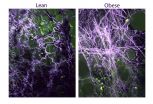(Press-News.org) Using DNA sequencing, researchers have accurately painted a clear picture of fish spawning activities in a marine protected area (MPA) and have created a baseline for continuing studies on the effects of climate variability on fish populations.
A group of Scripps Institution of Oceanography at UC San Diego researchers led by Ron Burton and Alice Harada collected 260 samples off the Ellen Browning Scripps Memorial Pier over a two-year period and used DNA barcoding to accurately identify over 13,000 fish eggs.
This study was also a collaborative effort between the Scripps Coastal Observing Research and Development Center (CORDC), which is led by researcher and study co-author Eric Terrill and the Burton Laboratory, which is led by study co-author Ron Burton. This study leveraged a network of radar antennas that allowed the researchers to map out ocean surface currents off the coast.
The eggs of 39 different species were identified. Modeling of how surface currents move the floating eggs indicate that probably all these species spawn within the La Jolla MPAs. The most abundant species were Speckled Sanddabs and Señoritas, but other species observed included Giant Seabass, White Seabass, Barracuda, and Sheephead. Despite the extensive sampling, the researchers did not find many species that are commonly found offshore, such as yellowtail.
The study, "Monitoring spawning activity in a southern California marine protected area using molecular identification of fish eggs," appears in the August 26, 2015 issue of the Public Library of Science publication PLoS One.
The researchers wanted to know which fish were spawning in the marine protected area by the Scripps Pier, when they were spawning, and which species were most abundant. Traditional studies of this type use visual characteristics to identify eggs but this study used DNA sequencing to more accurately distinguish fish eggs.
Previously, Scripps researchers used specimens from the Scripps Marine Vertebrate Collection to develop a catalog of DNA sequences of nearly all the marine fish species found in California waters. Through a process known as "DNA barcoding," each egg could be identified.
The results show that there was high consistency in the spawning patterns within the two-year period and reveals which fish are spawning locally and their breeding patterns. The researchers hope to use their results as a baseline for assessing future changes in spawning that may be caused by climate change and other factors.
"The primary purpose of this study was to provide a detailed picture of the species spawning in the MPAs in order to establish a baseline for future studies, which will allow us to examine the effects of climate change on the spawning patterns and fish species assemblage," said Harada, a Scripps PhD student. "In the future, we can also use our results to assess the efficacy of the MPAs."
The Coastal Observing Research and Development Center collects up-to-date oceanographic, weather, and water quality data. Using the CORDC data, researchers from the Burton Laboratory were able to map out the water conditions during the spawning stages to better understand when the fish laid the eggs, and how far the eggs may have traveled from their original spawning site.
"This project is a great example of how the synthesis of ocean circulation can support the challenges that biologists face in unraveling the mysteries behind our coastal fish species," said Terrill. "Linking state-of-the-art DNA techniques with a high-tech ocean monitoring system is an example of the ingenuity that takes place at Scripps.
"This study is a great example of interdisciplinary teamwork between two laboratories here at Scripps. We worked with the Terrill lab to use their data and expertise to calculate when and where the spawning occurred, and we were also able to determine where the hatched larvae might wind up using surface current data," said Burton, a professor of marine biology.
INFORMATION:
California Sea Grant (Project Number R/FISH-216) and the Richard Grand Foundation funded the study.
Other authors on this study include Elise Lindgren, Maiko Hermsmeier, Peter Rogowski, and Eric Terrill.
DURHAM, N.C. -- You're driving on a busy road and you intend to switch lanes when you suddenly realize that there's a car in your blind spot. You have to put a stop to your lane change -- and quickly.
A new study by Duke University researchers suggests that this type of scenario makes a person less likely to remember what halted the action -- for example, the make and model of the car in the blind spot.
People and non-human primates excel at "response inhibition." Our sophisticated brains allow us to cancel an action even when it's something engrained, like driving ...
ITHACA, N.Y. - After hours harvesting forage, managing livestock and milking cows, new Cornell University agricultural economic research shows family members who work on the family dairy farm make $22,000 less annually than comparable hired managers, but are handsomely compensated with "socioemotional" wealth.
"While $22,000 seems like a large penalty, there are nonfinancial rewards they experience working for the family business," said Loren Tauer, professor at Cornell's Charles H. Dyson School of Applied Economics and Management, who with lead author Jonathan Dressler ...
Compounds found in purple potatoes may help kill colon cancer stem cells and limit the spread of the cancer, according to a team of researchers.
Baked purple-fleshed potatoes suppressed the growth of colon cancer tumors in petri dishes and in mice by targeting the cancer's stem cells. Colon cancer is the second leading cause of cancer-related deaths in the U.S. and responsible for more than 50,000 deaths annually, according to the American Cancer Society.
Attacking stem cells is an effective way to counter cancer, according to Jairam K.P. Vanamala, associate professor ...
ITHACA, N.Y. - Women who are obese have a higher risk and a worse prognosis for breast cancer, but the reasons why remain unclear. A Cornell study published this month in Science Translational Medicine explains how obesity changes the consistency of breast tissue in ways that are similar to tumors, thereby promoting disease.
The study of mice and women shows obesity leads to a stiffening of a meshwork of material that surrounds fat cells in the breast, called the extracellular matrix, and these biomechanical changes create the right conditions for tumor growth.
The findings ...
A new study conducted by the Media Insight Project, a collaboration between the American Press Institute and The Associated Press-NORC Center for Public Affairs Research, found that while the similarities to the rest of their generation are numerous, there are some distinct differences in the way that Hispanic and African American Millennials use technology to access news and information. The source of their information is one area of difference: these young adults are more likely to use YouTube and Instagram for news than Millennials in general, though all groups rely ...
Howard Hughes Medical Institute (HHMI) scientists have discovered how the most common genetic defect in amyotrophic lateral sclerosis kills nerve cells. Their study suggests that the pores that allow molecules into and out of a cell's nucleus get jammed, a finding that could speed the search for other genes that promote this fatal illness.
In people who have amyotrophic lateral sclerosis (ALS), the motor neurons that operate the muscles deteriorate. Over time, the disease deprives patients of the ability to walk, swallow, and breathe, and they usually die within three ...
A study led by researchers from the U.S. Department of Energy's (DOE) SLAC National Accelerator Laboratory and the University of California, Los Angeles has demonstrated a new, efficient way to accelerate positrons, the antimatter opposites of electrons. The method may help boost the energy and shrink the size of future linear particle colliders - powerful accelerators that could be used to unravel the properties of nature's fundamental building blocks.
The scientists had previously shown that boosting the energy of charged particles by having them "surf" a wave of ionized ...
They're among the most powerful tools for shedding new light on cancer growth and evolution, but mathematical models of the disease for years have faced an either/or stand off.
Though models have been developed that capture the spatial aspects of tumors, those models typically don't study genetic changes. Non-spatial models, meanwhile, more accurately portray tumors' evolution, but not their three-dimensional structure.
A collaboration between Harvard, Edinburgh, and Johns Hopkins Universities including Martin Nowak, Director of the Program for Evolutionary Dynamics ...
New insight into methanotrophs, bacteria that can oxidise methane, may help us develop an array of biotechnological applications that exploit methane and protect our environment from this potent greenhouse gas.
Publishing in Nature, scientists led by Newcastle University have provided new understanding of how methanotrophs are able to use large quantities of copper for methane oxidation.
They have identified a new family of copper storage proteins called Csp that are present in a range of bacteria. These proteins store metal in a way that has not been seen previously ...
It's not a huge mystery why Los Angeles experiences earthquakes. The city sits near a boundary between two tectonic plates -- they shift, we shake. But what about places that aren't along tectonic plate boundaries?
For example, seismicity on the North American plate occurs as far afield as southern Missouri, where earthquakes between 1811 and 1812 estimated at around magnitude 7 caused the Mississippi River to flow backward for hours.
Until now, the cause of that seismicity has remained unclear.
While earthquakes along tectonic plate boundaries are caused by motion ...

